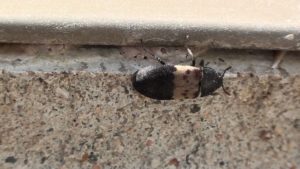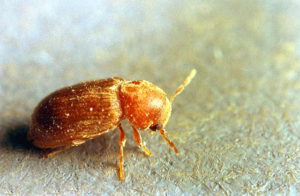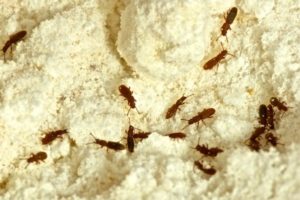Pantry Pests
Description
Pantry pests refer to a large group of beetles that infest stored products in both residential and commercial settings. These infestations result from either infested grains or infested processed products that are introduced into the home, storage facility or processing plant. Infestations of pantry beetles are not seasonal, instead they can occur anytime throughout the year.
Different species of panty beetles have different habits, habitats, behaviors and diet. Therefore, an accurate identification of the infesting pantry beetle by a pest management professional is crucial to successfully controlling an infestation. Also, a pest management professional’s knowledge, experience and the effective use of equipment and products will control the population of damaging insects. Quick control is extremely important since pantry beetles not only damage and destroy the products they feed on, but also contaminate products by depositing feces and castoff body parts in or on the product. If you discover a pantry beetle, don’t procrastinate – the problem is likely to get worse before it gets better.
Pantry Pest Feeding Categories
Stored product infesting beetles are broadly categorized based on their feeding behavior. The four categories of pantry beetles are internal feeders, external feeders, secondary feeders and scavengers.
INTERNAL FEEDERS
Internal feeders are beetles that complete their larval (grub) stage inside the seed, kernel or beans they damage. Some of the commonly encountered internal feeders are rice weevils, granary weevils and lesser grain borers. The weevils are relatively easy to identify since they have a long snout that sticks out from their head and has its functional mouthparts at the tip of the snout. Many experts consider the rice and granary weevils to be the world’s most important stored grain pests. The stored products favored by the rice and granary weevils include corn, barley, rice, wheat, sunflower seeds and pastas that are old and damaged.
EXTERNAL FEEDERS
External feeders complete their life cycle outside the grain. However, external feeders will feed on and damage both whole grains and processed products from whole grains. Some commonly encountered external feeders are cigarette beetles, drugstore beetles, warehouse and cabinet beetles. The types of stored products damaged by external feeders include pet foods, grains, cereals, seeds, spices, pasta, nuts, dried fruits and tobacco. The warehouse and cabinet beetles will feed on animal hair, taxidermy skins, dried fruits, milk and dead insects. These beetles will infest the attic space of a home where they may be feeding on a dead rodent or a bird’s nest.
SECONDARY FEEDERS
This category of pantry beetles infests old, wet and moldy stored products that may be damaged by other groups of stored product insects. The secondary feeders often do not directly feed on the product itself, but feed on the mold and fungus growing on the products. One of many possible causes of a secondary feeder infestation is old rodent baits set out, but not gathered up, after the rodent problem was solved. Some commonly encountered secondary feeders include mealworms, spider beetles and foreign grain beetles. The mealworm beetle infests old products, but is also a valuable insect since its larval stage is raised and sold as fish bait and food for pets like lizards.
SCAVENGERS
This group of pantry beetles is not able to infest whole grains or kernels unless the product was damaged by an external or internal feeding beetle or in the harvesting or storage process. The most likely situations causing a scavenger beetle infestation are broken pieces of whole grains, grain dust or dry, processed products made from a particular type of grain or grain product. The more common and damaging pantry beetles in this group are the red flour beetle, the confused flour beetle and the sawtoothed grain beetle. Processed products that can be infested include flour, pet foods, corn meal, bran, beans, rice, dried fruits, pasta, processed and smoked meat and cheese products (infested by the red legged ham beetle).
Prevention of Pantry Pest Damage
When a stored pest infestation is discovered, contact your pest management professional for assistance. Your pest management professional can give you an accurate identification of the pest and knows what to do to eliminate the infestation. His knowledge of the pest’s habitat helps him to locate the infestation site in a part of the house that may be outside the pantry or kitchen.
Examine food packages to ensure you are not purchasing damaged foods or damaged food packages. Discard any packages of products that are infested or return the infested food to the store manager where it was bought. When purchasing bulk products, look for any adult or larval insect stages in the bin or within the product.
Use products before they get old. Employ the FIFO concept – first in, first out. Buy foods in small-sized packages so the food is used before it gets old. Pay attention to dates on the stored product packages and use the older products before the newer ones.
Keep the pantry and other storage areas clean and well organized since spilled foods attract pests and good organization helps a homeowner conduct a good inspection. Clean the cracks and crevices in your pantry. Don’t leave bits of food, sugar, flour or grains inside the pantry or on the storage shelves. A vacuum is a very helpful cleaning tool, but make sure you discard the vacuum bag after use. If insects are left in the bag, they could create an infestation inside the bag.
If practical, store foods in containers that are insect-proof to prevent an infestation. Glass or plastic containers with tight-fitting lids are insect-proof, while cardboard, wood or paper containers are not.
Homeowners should not use insecticides. The risk of contaminating foods with insecticides must be avoided. If insecticide applications are needed, your pest management professional will apply them in a manner that doesn’t risk contamination.
MORE ABOUT BEETLES
The following pantry pests are just a few of the most popular beetles you will find in New York City.

Larder Beetles
The larder beetle may get its name from the fact that it is a pest of cured meat and other stored food products. It is a member of the beetle group called dermestid beetles.
When they invade a home, larder beetles move into dark areas where they can find food. They prefer to feed on dead insects and stored meat or cheese. They will also feed on feathers, skins, horns and dry pet food. They will infest pantries and storerooms where people store pet food. Larder beetles also infest nests of squirrels and rats in wall voids and attics. They can move from these areas into almost any part of a home.

Cigarette Beetles
The cigarette beetle, Lasioderma serricorne (Fabricius), gets its name from attacking stored tobacco. It is a stored product pest throughout the world.
The adult beetle is a small insect (2 to 3 mm). It is usually light brown. The head is bent down and barely visible from above. This gives the beetle a rounded or “humped” appearance.
The most visible signs of cigarette beetles are the adults, holes in packaging and debris coming out of packages. Adults are active fliers and are observed as small brown beetles. As they exit from infested materials, they often chew their way free, which leaves holes in the packaging. As the larvae continue to feed, fine particles of debris come from the packaging.

Flour Beetles
The flour beetles include several species. Flour beetles are pests of flour and cereal products. They are common in homes and grocery stores. They also infest mills and food processing facilities.
The red flour beetle originally came from Asia. In the United States it is most common in the South. The red flour beetle is a good flier. It sometimes flies from fields into buildings.
Some people suspect that the confused flour beetle got its name from being confused with the red flour beetle. The confused flour beetle originally came from Africa. In the United States it is one of the most important pests of home pantries and grocery stores. Although it has wings,it typically doesn’t fly.
✓ Certified Technicians
✓ Extensive Industry Training
✓ Established in 1896
✓ Inspections
✓ Environmentally Conscious
✓ Full-Service Solutions
✓ FREE Consultations
✓ Maintenance Programs
✓ Rodent Exclusion
✓ Bed Bug Canine Inspections
✓ Guaranteed Satisfaction
✓ Emergency Service

